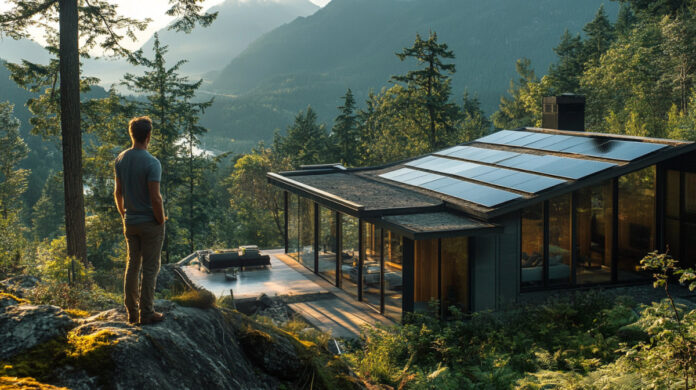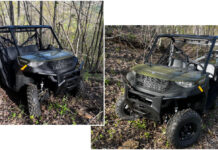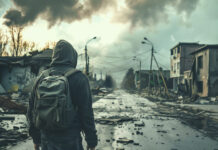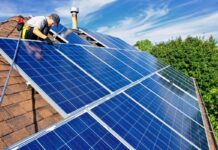I never thought I would say this, but I feel pretty well prepared.
Completing the solar power system has been a big step in making us ready for whatever the future holds, and that gives me a great deal of relief. It’s good to know that we should be able to have refrigeration, lighting and other basic electrical needs in a short-term or long-term disaster or TEOTWAWKI situation.
As I write this at 2:15 p.m., the system is producing three times as much power as we are consuming and our batteries are 94 percent charged. As long as we get five hours of full sunlight over two days, we should be able to operate independently of the grid. On those days when we have full sun two or more days in a row, we’ll have excess power and can to use our dryer, bake something in the oven, run the AC, or otherwise “spend” all the “extra” power we are producing.
Don’t get me wrong, I know solar may get knocked out should the world as we know it end. We have no ideas if our system’s components will still function after an EMP or nuclear war. A super volcano or a large meteor strike could throw so much ash or dust into the air that there won’t be sufficient sun to generate power. Likewise, my solar system will not save me from crisis-created criminals and may, in fact, attract marauders, despite being difficult to see from the road.
But I still feel good. I am still happy knowing that our independence and self-reliance have taken a giant step forward. Regardless if this helps in a nuclear war or other global disaster, it will make our lives easier in many of those minor disruptions, regional natural disasters, and local grid failures.
Running a Freezer is a Game Changer
My planning had always been to eat and can up the food in the freezer as fast as possible after the SHTF because with generator power only we cannot run the freezer for long.
I had also planned to keep things in coolers on the deck during the winter, counting on the weather to provide my “refrigeration.” For example, we would not open a jar of mayonnaise in May because it would go bad. Come November, however, we can have tuna or chicken salad and store the extra mayo in the cooler on the deck. Using nature’s refrigeration would also be useful if we killed large game.
A spring box might also work to keep leftovers cool overnight or to cool a beverage, even if it’s just ice tea we brewed ourselves. Those remain viable options, but with a solar power system that can run the refrigerator and the freezer, we have new options.
To be honest, I hadn’t incorporated that into our plans, but now we can store more meat in the freezer and count on the likelihood of them being available. (Of course, bacon is at the top of my list. We have 10 pounds in there now.) As the freezer inevitably grows empty after the SHTF, we can freeze meat we hunted or vegetables from the garden.
I’d love to get a large freezer chest to complement our stand-up freezer, but I don’t see that happening any time soon.
Refrigeration
Refrigeration also gives us new options for that last-minute shopping spree we are hoping to go on. I maintain a list of things to buy if we have advanced warning of an impending disaster. Beside topping off canned and dried food, this has included fresh foods that can be stored for a few weeks, like bags of potatoes and onions, cabbage, apples, etc. Refrigeration opens up more possibilities, including cheese and other dairy products, meats, and fruits.
Then there is the value of refrigeration for storing leftovers. The makes it possible to cook an extra-large batch of stew or chili, knowing we can refrigerate the leftovers and eat it again in two or three days.
The solar power system is giving us options I had not even considered. For example, it will also give us a way to store garden produce before we can it up or dehydrate it, since we should be able to run the dehydrator on the solar power. It will also allow us to run the egg incubator and hatch our own chicks. I have a small incubator that holds only 9 eggs, but even if only half of them hatch, we can make batches of chicks to replenish our layers as they age out. And the extra roosters? They’ll go into the pot. Not only will the ability to raise chicks help ensure our food supply, chicks or chickens will be a valuable barter item.
I look at the article on solar power I wrote in May 2022, and I have to chuckle. The system we just installed was at least twice as powerful as the ones I discussed two years ago, and I already wish I had more battery storage and a larger generator.
What’s Next?
Prepping is a journey, and it is OK from time to time to stop and appreciate how far you’ve come. That’s what I’m going to do. I am going to stop adding to my preps, take a breath, and relax for a few months. I’ll still refill the freezer and buy canned food to replenish what we rotate out, but there will be a prepping hiatus while my finances recover from the solar power purchase.
Looking ahead, my priority in 2025 is going to be replacing my oldest food in 5-gallon buckets and #10 cans. I’ve bought a few Auguson Farms #10 cans in the past two years, but most of our long-term storage foods are from 2013 or earlier. In 2020, that didn’t sound like that long ago. As 2025 approaches, those foods are twelve years old, with some in the 20 to 25-year range.
I’d like to get at least 1,000 pounds of wheat and 500 pound of rice and pack my own long-term storage buckets. Over the years, Karl and I have packed many a mylar-bag lined bucket with grains or beans after tossing in some oxygen absorbers. I need a new bag sealer, but I could enlist his help again. Then I could feed the old stuff to the chickens.
Karl recommends I just buy new stuff and hold on to the old. He says I can always feed it to the chickens after the SHTF. But where to store it is the big question. I have no outbuildings, and the garage and basement are at capacity.
Stacking
Besides stacking food buckets, I’d like to start stacking silver and maybe get some gold. Last time I was at a local pawnshop, which does a brisk trade in silver, junk silver was selling at 25 times face. That seems high to me, even when silver was more than $30. No doubt it will be even higher when I get around to buying some in 2025.
The question is, do I buy silver from a big online company and have it recorded on my credit card? Or do I pay a little extra and preserve my privacy? If I make a big purchase, it will probably pay to shop in a city, maybe even one in another state. I can pick it up in person from a coin store that offers a better deal than my local outlet. That is one thing I could do with the $1,800 I found.
Eventually, I’d like to get a cheap drone and learn how to fly it. Once I become a decent drone pilot, I’ll upgrade to a more expensive drone with better capabilities. This is one of those purchases for which there is no reason to hurry. Every month I wait, the technology improves and/or becomes less expensive. And while a drone may be handy, I don’t see it as a necessity.
An aspirational desire would be to purchase a double stack 1911 or 2011, like the Staccato. But at $3,000 to $5,000, I don’t see that happening unless I get some kind of windfall. However, the Apollo 11 from Live Free Armory is a double-stack 1911 that sells for just under $1,000. An acceptable compromise and another thing I could do with the $1,800.
Time is your Friend
My point is, even though we are well-prepared, there is always more to do and more goodies I want. But you can’t do it all at once, or even over30 years. Don’t let that stop you from trying. Slow progress is better than no progress. Start small, if that’s all you can afford. Take baby steps, if you must. But prep over time and you will be pleasantly surprised at how far you get. I know I am.







